Your Cart is Empty
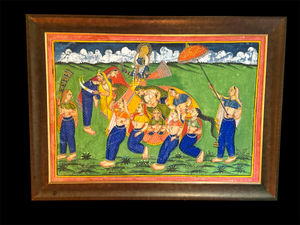
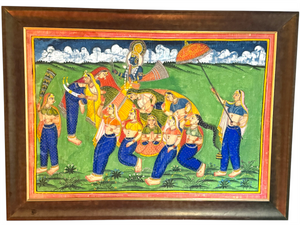
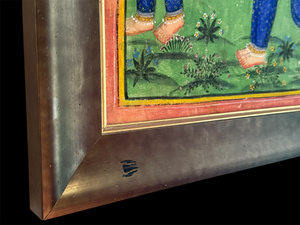
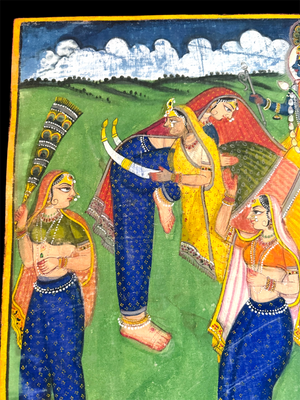
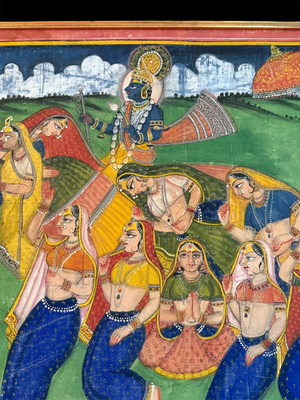
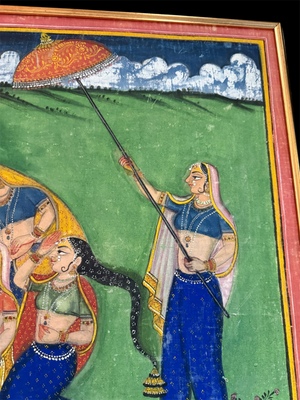
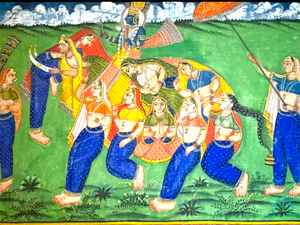
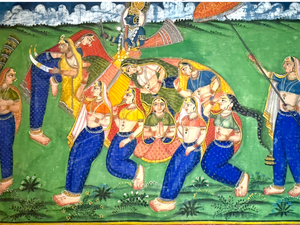
Antique Krishna Pichwai Temple Painting
$3,850.00
Antique Pichwai Painting of Krishna, the Nari Kunjar and Gopis. Circa 1900. Hand painted on stiffened cotton cloth with stone ground natural pigments.
The painting is currently framed to conservator quality. There is one small mark on the frame, as shown in the photo.
The word Pichwai (also known as pichhwai, pichvai and pechhavai) has its roots in the Sanskrit words pich (behind) and wai (hanging). Pichwai was first used as a form of devotional painting in the 17th century at the Nathdwara temple built in 1692 near Udaipur, Rajasthan, and has since become enshrined as an art form in its own right. Painted on cloth using stone ground natural pigments, the subject matter was almost always associated with Krishna, Radha and gopis, and the paintings were often made in set of five pieces and hung as backdrops and surrounds to the main altar. The purpose of Pichwais, other than artistic appeal and devotion, was to narrate tales of Krishna to the illiterate. Temples had sets with different images, which were changed according to the calendar of festivals celebrating the deity. Creating a genuine pichhwai could take months and required considerable skill. A single painting was often painted by several artists working together under the supervision of a master.
The elegant style of Pichwai has become popular over time, and paintings created with this technique are no longer only to be found in temples. Painting is now carried out to meet a growing demand for art to hang in the homes of devotees and art connoisseurs alike, and the style is changing to meet modern tastes. This makes genuine antique pieces that were originally commissioned for temples particularly valuable, and of growing historical significance.
Subject Matter
Our temple painting depicts Krishna and the Nari Kunjar. The Nari-Kunjar or Nav Nari Kunjar is an artistic motif that arose during 17th century and was inspired by Persian art, whereby a group of nine beautifully dressed and bejewelled women (nari) aesthetically combine to form an elephant (kunjar). The women are dancers and/or musicians and are joyful in their demeanour. The imagery symbolises divine love and devotion to Lord Krishna, while the elephant represents strength, wisdom and good fortune. It also represents the universal connection that each living being has with the almighty. However, a more playful meaning is that the women were said to have combined in elephant form to stop Krishna from leaving. A very comprehensive discussion of the symbolism and historical context behind the Nari Kunjar may be found here.
Some elements of this painting are typical and some are unique. In typical style, four of the figures form the elephant's legs and the plait of the last women forms the tail of the elephant. The tusk is formed by a woman carrying identical two items, in this case what appear to be actual tusks rather than the swords or fans usually depicted. Krishna riding the elephant carries the usual elephant goad. However, the female figures that forms the belly does not play a musical instrument and the figure forming the elephant's back does not carry a chhatri, or canopy. Instead, two additional female figures join the groups as attendants, the foremost carrying a peacock feather fan and the final figure holding the canopy to shade the figure of Krishna.
Provenance
This antique Pichwai painting of Krishna and the Nari-Kunjar is estimated at circa 1900. It was purchased from Rohit Kaicker at Gallery 29 Sunder Nagar New Delhi in 2016. We have since had it professionally mounted.
Measurements:
87 x 60 centimeters
34 x 24 inches
This item can be picked up in person or delivered via courier. Please contact us at admin@kashgar.com.au for a shipping quote within Australia or overseas. In addition, we can personally deliver as far north as Brisbane or as far south as Sydney.








